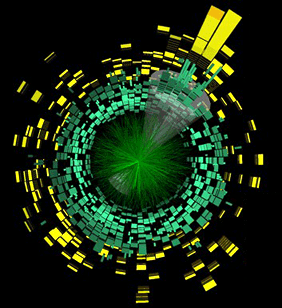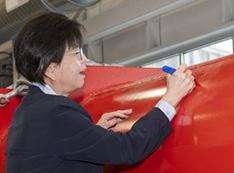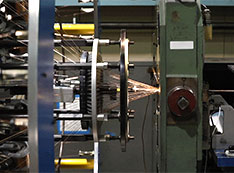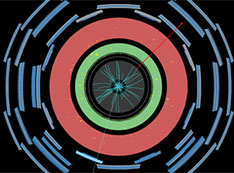Contact: Peter Genzer, (631) 344-3174 | Written by Kendra Snyder
NOTE: The following news release is being distributed by CERN, the European laboratory for particle physics, about the first measurements taken from lead-ion collisions in the ATLAS detector at the Large Hadron Collider (LHC). The measurements are of a phenomenon known as "jet quenching" — a phenomenon first observed in 2003 (see related link at bottom of page) at the Relativistic Heavy Ion Collider (RHIC) at the U.S. Department of Energy’s Brookhaven National Laboratory. Studying jet quenching — the suppression of the stream of particles materializing from a quark or gluon emerging from particle collisions — in LHC’s higher-energy collisions could reveal more details about a very hot, dense matter known as quark-gluon plasma that has been seen in RHIC’s experiments (see related link at bottom of page). Brookhaven scientists and engineers contributed significantly to a key part of the ATLAS detector system, known as the liquid argon calorimeter, which played an important part in this measurement. In addition, Brookhaven physicist Peter Steinberg is a principal author of the Physical Review Letters paper mentioned below and serves as the co-convener for the ATLAS heavy ion physics group.
LHC Experiments Bring New Insight into Primordial Universe
November 29, 2010

Event display recorded by ATLAS of a lead-ion collision where one jet was emitted with large transverse energy and no evident recoiling jet. (courtesy of CERN).
GENEVA – After less than three weeks of heavy-ion running, the three experiments studying lead ion collisions at the LHC have already brought new insight into matter as it would have existed in the very first instants of the Universe’s life. The ALICE experiment, which is optimized for the study of heavy ions, published two papers just a few days after the start of lead-ion running. Now, the first direct observation of a phenomenon known as jet quenching has been made by both the ATLAS and CMS collaborations. This result is reported in a paper from the ATLAS collaboration accepted for publication yesterday in the scientific journal Physical Review Letters. A CMS paper will follow shortly, and results from all of the experiments will be presented at a seminar on Thursday, December 2 at CERN. Data taking with ions continues to December 6.
“It is impressive how fast the experiments have arrived at these results, which deal with very complex physics,” said CERN’s Research Director Sergio Bertolucci. “The experiments are competing with each other to publish first, but then working together to assemble the full picture and cross check their results. It’s a beautiful example of how competition and collaboration is a key feature of this field of research.”
One of the primary goals of the lead-ion program at CERN is to create matter as it would have been at the birth of the Universe. Back then, the ordinary nuclear matter of which we and the visible Universe are made could not have existed: conditions would have been too hot and turbulent for quarks to be bound up by gluons into protons and neutrons, the building blocks of the elements. Instead, these elementary particles would have roamed freely in a sort of quark gluon plasma. Showing beyond doubt that we can produce and study quark gluon plasma will bring important insights into the evolution of the early Universe, and the nature of the strong force that binds quarks and gluons together into protons, neutrons and ultimately all the nuclei of the periodic table of the elements.
When lead-ions collide in the LHC, they can concentrate enough energy in a tiny volume to produce tiny droplets of this primordial state of matter, which signal their presence by a wide range of measurable signals. The ALICE papers point to a large increase in the number of particles produced in the collisions compared to previous experiments, and confirm that the much hotter plasma produced at the LHC behaves as a very low viscosity liquid (a perfect fluid), in keeping with earlier observations from Brookhaven’s RHIC collider. Taken together, these results have already ruled out some theories about how the primordial Universe behaved.
“With nuclear collisions, the LHC has become a fantastic 'Big Bang' machine,” said ALICE spokesperson Jürgen Schukraft. “In some respects, the quark-gluon matter looks familiar, still the ideal liquid seen at RHIC, but we’re also starting to see glimpses of something new.”
The ATLAS and CMS experiments play to the strength of their detectors, which both have very powerful and hermetic energy measuring capability. This allows them to measure jets of particles that emerge from collisions. Jets are formed as the basic constituents of nuclear matter, quarks and gluons, fly away from the collision point. In proton collisions, jets usually appear in pairs, emerging back to back. However, in heavy ion collisions the jets interact in the tumultuous conditions of the hot dense medium. This leads to a very characteristic signal, known as jet quenching, in which the energy of the jets can be severely degraded, signaling interactions with the medium more intense than ever seen before. Jet quenching is a powerful tool for studying the behavior of the plasma in detail.
“ATLAS is the first experiment to report direct observation of jet quenching,” said ATLAS Spokesperson Fabiola Gianotti. “The excellent capabilities of ATLAS to determine jet energies enabled us to observe a striking imbalance in energies of pairs of jets, where one jet is almost completely absorbed by the medium. It’s a very exciting result of which the Collaboration is proud, obtained in a very short time thanks in particular to the dedication and enthusiasm of young scientists.”
“It is truly amazing to be looking, albeit on a microscopic scale, at the conditions and state of matter that existed at the dawn of time,” said CMS Spokesperson Guido Tonelli. “Since the very first days of lead-ion collisions the quenching of jets appeared in our data while other striking features, like the observation of Z particles, never seen before in heavy-ion collisions, are under investigation. The challenge is now to put together all possible studies that could lead us to a much better understanding of the properties of this new, extraordinary state of matter."
The ATLAS and CMS measurements herald a new era in the use of jets to probe the quark-gluon plasma. Future jet quenching and other measurements from the three LHC experiments will provide powerful insight into the properties of the primordial plasma and the interactions among its quarks and gluons.
With data taking continuing for over one more week, and the LHC already having delivered the programmed amount of data for 2010, the heavy-ion community at the LHC is looking forward to further analyzing their data, which will greatly contribute to the emergence of a more complete model of quark gluon plasma, and consequently the very early Universe.
CERN Contact
CERN Press Office press.office@cern.ch
+41 22 767 34 32
+41 22 767 21 41
For more information, read the symmetry breaking story at http://www.symmetrymagazine.org/breaking/2010/11/26/new-insight-into-primordial-universe-from-the-lhc/.
2010-11204 | INT/EXT | Newsroom







